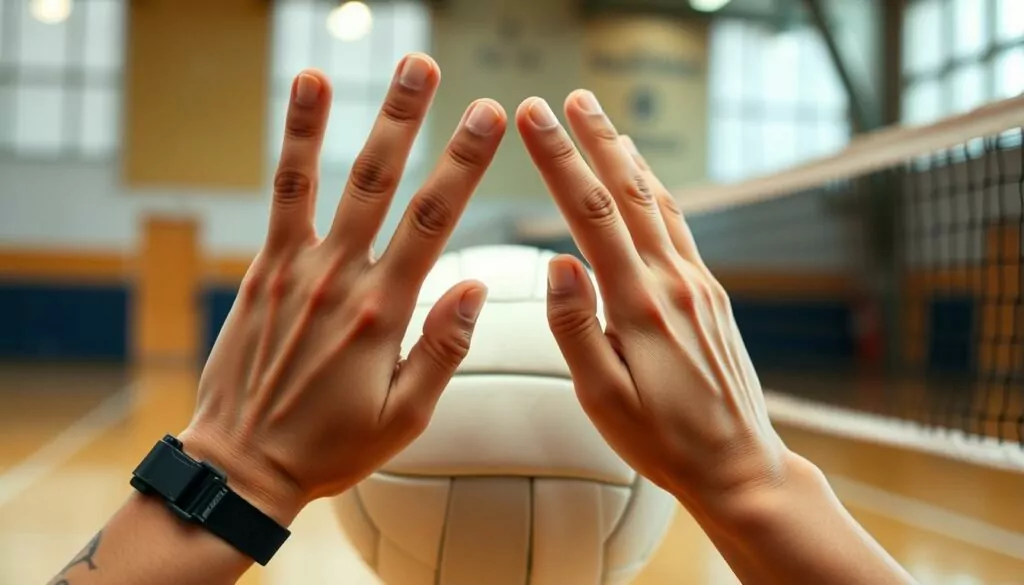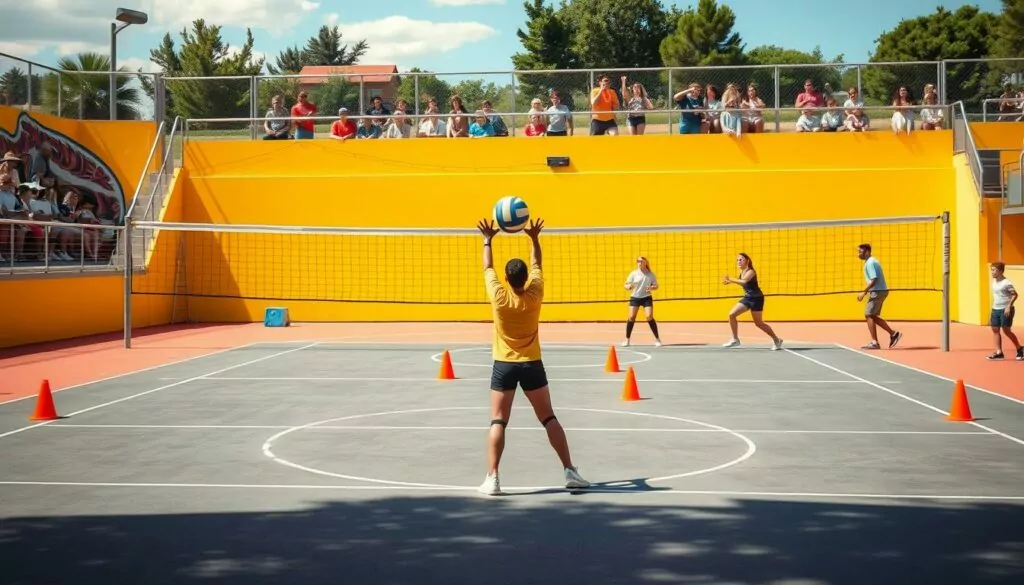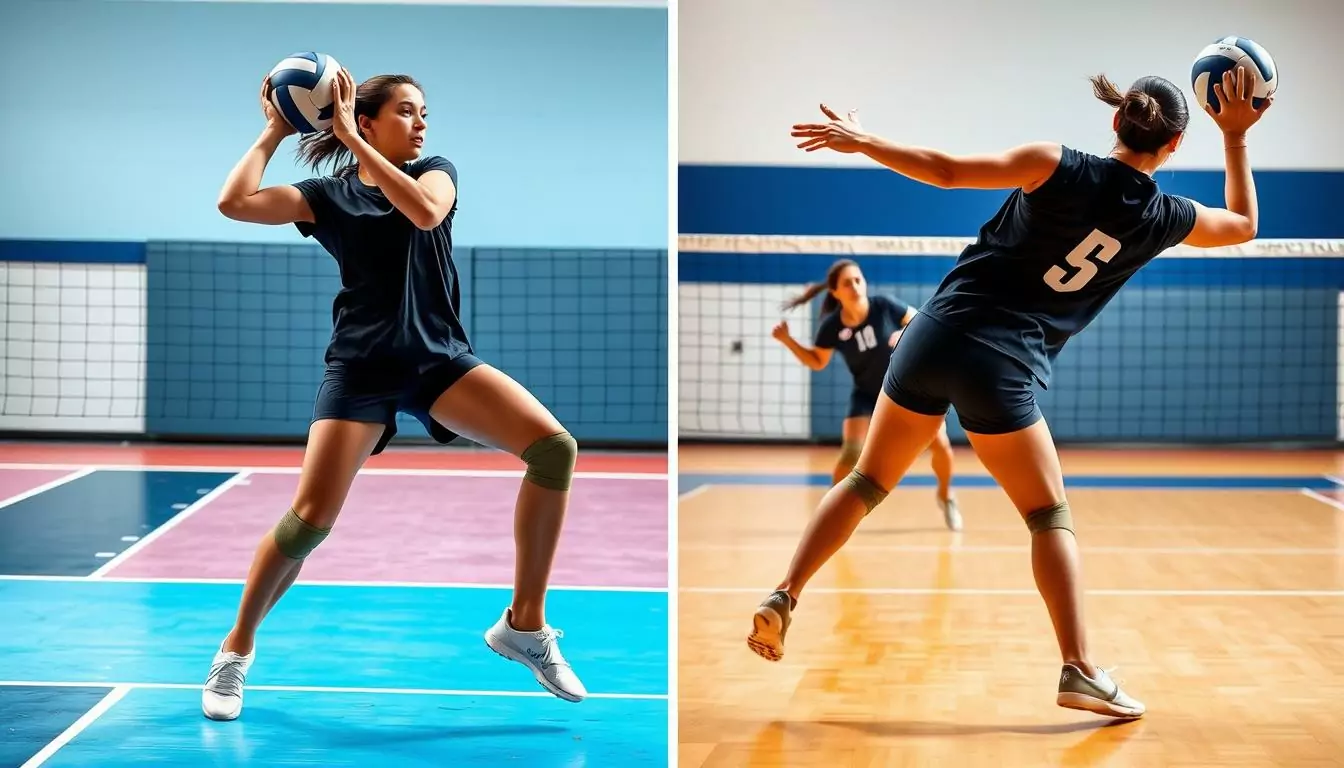I’ll never forget the day I fell in love with volleyball setting. It was during a high school match, and our team’s setter got injured. As the backup, I was thrust into the spotlight. My heart raced as I stepped onto the court, but as soon as I felt the ball on my fingertips, something clicked. The thrill of orchestrating plays and setting up my teammates for powerful spikes was unmatched. That moment ignited my passion for mastering setting techniques in volleyball.
Since then, I’ve dedicated countless hours to honing my craft and learning the volleyball setting fundamentals. Now, I’m excited to share my knowledge with you. Whether you’re just starting out or looking to refine your skills, this guide will walk you through essential setting techniques in volleyball, from basic stance to advanced strategies.
Key Takeaways
- Proper hand positioning is crucial for accurate sets
- Footwork patterns play a vital role in setting efficiency
- Understanding different attack strategies enhances setter performance
- Regular practice of setting drills improves consistency and control
- Mastering quick sets and fast-tempo plays elevates your game
- Adapting to various hitter types is key for team success
Understanding the Fundamentals of Volleyball Setting

Setting is a crucial skill in volleyball that can make or break a team’s offensive strategy. I’m excited to dive into the core elements of this technique, exploring everything from the basic stance to the intricate mechanics involved.
Basic Setting Stance and Body Position
The volleyball setting stance forms the foundation of effective setting. I always start with my feet shoulder-width apart, knees slightly bent, and weight on the balls of my feet. This position allows for quick movements and stable ball control. My arms are relaxed at my sides, ready to spring into action.
Core Mechanics of Setting Motion
The setting motion is a fluid sequence that begins with footwork and ends with fingertip control. As the ball approaches, I square my body to the target, bringing my hands up to form a diamond shape above my forehead. The actual contact with the ball is brief but crucial, involving a gentle push from my legs, core, and arms working in unison.
The Role of a Setter in Volleyball
A setter is often called the quarterback of volleyball. We’re responsible for running the offense, making split-second decisions, and delivering precise passes to our hitters. Our role extends beyond just setting; we need to read the defense, communicate with teammates, and sometimes even act as a decoy.
| Setter Responsibility | Impact on Team |
|---|---|
| Ball Distribution | Keeps offense unpredictable |
| Court Awareness | Enables strategic play-calling |
| Leadership | Boosts team morale and coordination |
Mastering setting fundamentals takes time and practice, but it’s the key to becoming a valuable asset to any volleyball team. Remember, a great setter doesn’t just set the ball; they set the tone for the entire match.
Setting techniques in volleyball: A Step-by-Step Breakdown

I’m excited to dive into the nitty-gritty of volleyball setting techniques. Let’s break down the key components that make a great setter. From hand positioning to footwork, we’ll cover it all.
Proper Hand Positioning and Ball Contact
Setting hand positioning is crucial for accurate ball control. I form a triangle with my thumbs and index fingers, keeping my hands relaxed. This shape cradles the ball perfectly, allowing for precise control. When the ball makes contact, I aim to touch it with my fingertips, not my palms. This gives me better feel and control over the set’s direction and speed.
Setting Footwork Patterns
Effective setting footwork is the foundation of great setting. I always start with a balanced stance, feet shoulder-width apart. As the ball approaches, I take quick, short steps to get into position. The key is to move early and adjust late. This allows me to be stable when making contact with the ball.
| Footwork Pattern | Description | Benefit |
|---|---|---|
| Shuffle Step | Quick side-to-side movement | Maintains body orientation |
| Crossover Step | Longer distance coverage | Faster movement to ball |
| Drop Step | Quick backward movement | Adjusts for deep passes |
Wrist and Finger Control
Wrist and finger control are essential for adding finesse to your sets. I keep my wrists firm but not rigid. This allows for subtle adjustments in the set’s trajectory. My fingers spread wide, creating a larger surface area for ball contact. By varying the pressure from my fingertips, I can control the speed and spin of the ball, making it easier for my hitters to attack effectively.
Mastering Setting Accuracy and Control

Perfecting setting accuracy and control is crucial for any volleyball player aiming to excel in this position. I’ve found that consistent practice and focused drills are key to improving these skills. Let’s dive into some effective methods to enhance your setting game.
Setting accuracy drills are essential for developing precision. One drill I recommend is the Wall Target Practice. Stand about 3 feet from a wall with targets marked at different heights. Set the ball repeatedly, aiming for these targets. This drill hones your ability to control the ball’s trajectory and height.
Setting timing is another critical aspect to master. The Toss and Set drill helps improve your timing and hand positioning. Have a partner toss the ball to you from different angles and distances. Your goal is to set the ball back to a specific spot on the court. This exercise enhances your ability to adjust quickly to various ball speeds and trajectories.
| Drill Name | Focus Area | Description |
|---|---|---|
| Wall Target Practice | Accuracy | Set ball to targets on wall |
| Toss and Set | Timing | Set balls tossed from various angles |
| Rapid-Fire Setting | Consistency | Quick successive sets to different positions |
Remember, becoming a skilled setter takes time and dedication. Practice these drills regularly, and you’ll see significant improvements in your setting accuracy and timing. Stay focused on your goals and keep pushing yourself to new heights in your volleyball journey.
Advanced Setting Strategies for Different Attacks
Setting for different volleyball attacks requires skill and strategy. I’ve learned that mastering various setting techniques can elevate your team’s offensive game. Let’s explore some advanced strategies that will help you become a more versatile setter.
Quick Sets and Fast-Tempo Plays
Quick sets are crucial for catching the opponent off guard. I focus on delivering the ball quickly and accurately to the hitter. This fast-tempo play keeps the blockers guessing and creates gaps in their defense. The key is to maintain a consistent setting location while varying the speed and height of your sets.
Back Row Setting Techniques
Back row setting adds a new dimension to your team’s attack. I’ve found that it’s essential to maintain good body position and footwork when setting from the back row. This technique allows for more offensive options and can confuse the opposing blockers. Practice setting from different back row positions to improve your versatility.
Setting for Different Hitter Types
Each hitter has unique strengths and preferences. I adjust my setting technique based on the hitter’s style. For power hitters, I focus on higher sets that allow them to generate maximum force. Quick hitters benefit from lower, faster sets. Middle blockers often prefer sets close to the net. By tailoring your sets to each hitter’s strengths, you can maximize your team’s offensive potential.
- Power hitters: Higher sets for maximum force
- Quick hitters: Lower, faster sets
- Middle blockers: Sets close to the net
Remember, the key to successful setting for different volleyball attacks lies in adaptability and precision. By mastering these advanced strategies, you’ll become an invaluable asset to your team’s offense.
Common Setting Drills and Practice Methods
To become a great setter in volleyball, you need to practice regularly. I’ve put together some effective volleyball setting drills and practice methods to help you improve your skills. These exercises will boost your accuracy, speed, and decision-making abilities on the court.
Solo Setting Exercises
When you’re alone, try wall setting drills. Stand about three feet from a wall and set the ball against it, catching and resetting it quickly. This helps build hand strength and improves your touch. You can also practice overhead tosses to yourself, focusing on consistent ball spin and height.
Partner Setting Drills
With a partner, try rapid-fire setting. Stand about 15 feet apart and set the ball back and forth as fast as you can while maintaining good form. This drill enhances your reaction time and precision. Another useful exercise is the three-person triangle drill, where you rotate positions after each set, simulating game-like movements.
Game-Situation Setting Practice
To prepare for real matches, set up mock game scenarios. Practice setting from different court positions to imaginary hitters. Mix in some serve receive drills where you move to set after a pass. These setting practice methods will help you adapt to various game situations and make quicker decisions during play.
